LSC UoS BA - Corporate Financial Statements: Uses and Limitations
VerifiedAdded on 2023/06/18
|7
|1249
|172
Report
AI Summary
This report provides an analysis of corporate financial statements, focusing on their uses and limitations within the context of financial reporting standards. It highlights key accounting concepts, such as the money measurement concept, going concern concept, business entity concept, dual aspect concept, and historical cost concept, which are fundamental to the preparation of these statements. The report also examines the qualitative characteristics of financial reporting as governed by the International Accounting Standards Board (IASB), including relevance, materiality, faithful representation, comparability, verifiability, timeliness, and understandability. These characteristics ensure that financial information is useful and reliable for decision-making. The report concludes by emphasizing the importance of accounting policies and qualitative characteristics in achieving accurate and transparent financial reporting for organizations. Desklib provides access to a variety of similar solved assignments and past papers to aid students in their studies.

CORPORATE FINANCIAL
STATEMENTS, THEIR USES
AND LIMITATIONS
STATEMENTS, THEIR USES
AND LIMITATIONS
Paraphrase This Document
Need a fresh take? Get an instant paraphrase of this document with our AI Paraphraser
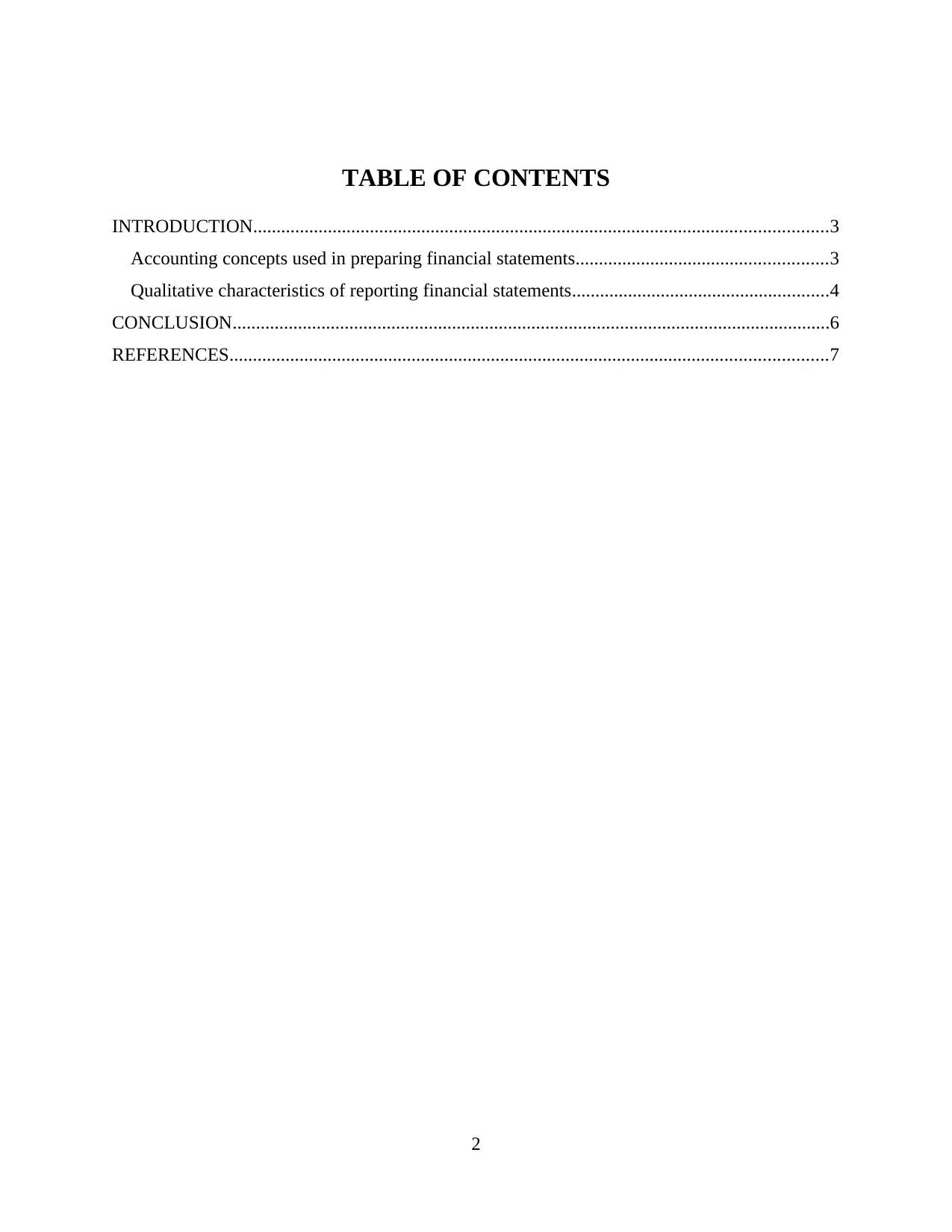
TABLE OF CONTENTS
INTRODUCTION...........................................................................................................................3
Accounting concepts used in preparing financial statements......................................................3
Qualitative characteristics of reporting financial statements.......................................................4
CONCLUSION................................................................................................................................6
REFERENCES................................................................................................................................7
2
INTRODUCTION...........................................................................................................................3
Accounting concepts used in preparing financial statements......................................................3
Qualitative characteristics of reporting financial statements.......................................................4
CONCLUSION................................................................................................................................6
REFERENCES................................................................................................................................7
2
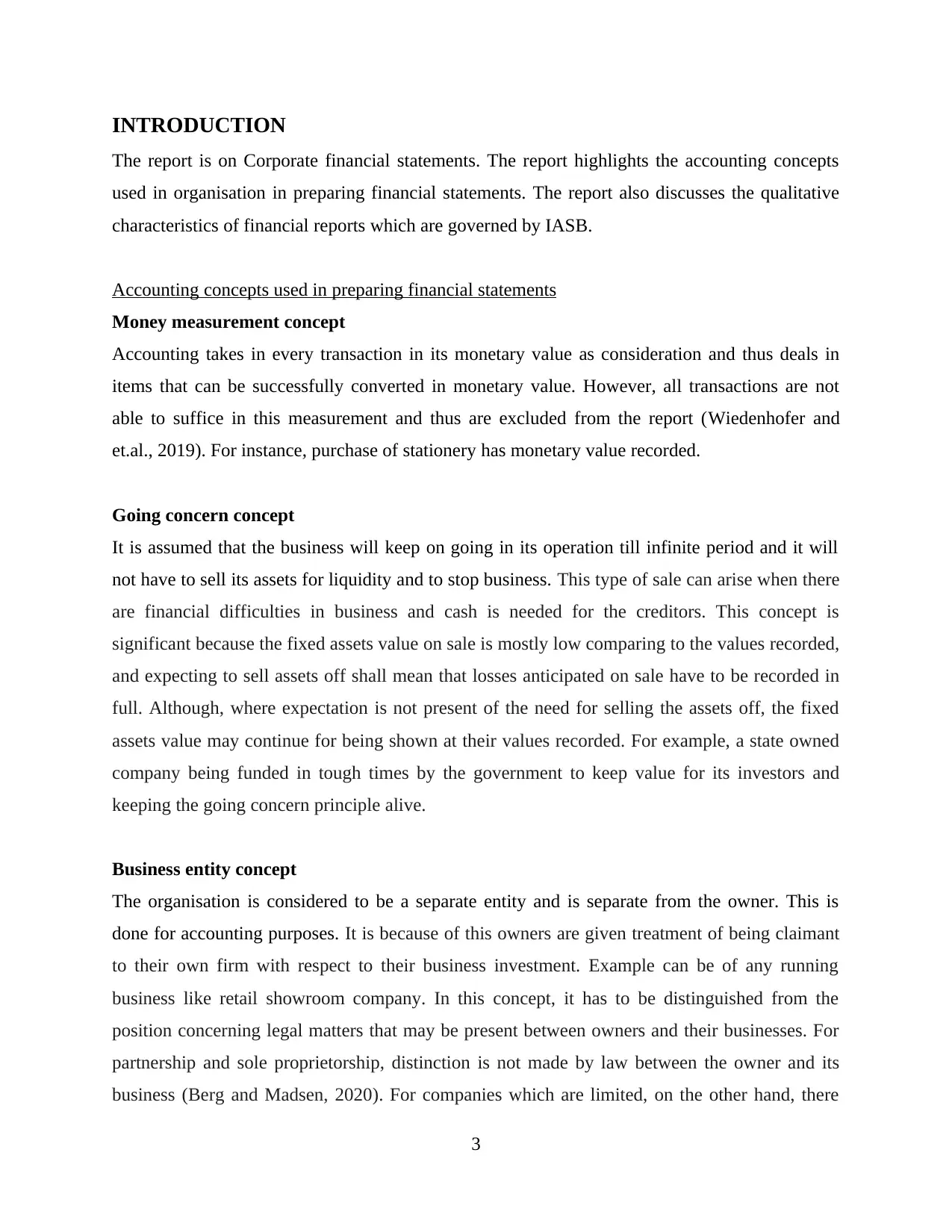
INTRODUCTION
The report is on Corporate financial statements. The report highlights the accounting concepts
used in organisation in preparing financial statements. The report also discusses the qualitative
characteristics of financial reports which are governed by IASB.
Accounting concepts used in preparing financial statements
Money measurement concept
Accounting takes in every transaction in its monetary value as consideration and thus deals in
items that can be successfully converted in monetary value. However, all transactions are not
able to suffice in this measurement and thus are excluded from the report (Wiedenhofer and
et.al., 2019). For instance, purchase of stationery has monetary value recorded.
Going concern concept
It is assumed that the business will keep on going in its operation till infinite period and it will
not have to sell its assets for liquidity and to stop business. This type of sale can arise when there
are financial difficulties in business and cash is needed for the creditors. This concept is
significant because the fixed assets value on sale is mostly low comparing to the values recorded,
and expecting to sell assets off shall mean that losses anticipated on sale have to be recorded in
full. Although, where expectation is not present of the need for selling the assets off, the fixed
assets value may continue for being shown at their values recorded. For example, a state owned
company being funded in tough times by the government to keep value for its investors and
keeping the going concern principle alive.
Business entity concept
The organisation is considered to be a separate entity and is separate from the owner. This is
done for accounting purposes. It is because of this owners are given treatment of being claimant
to their own firm with respect to their business investment. Example can be of any running
business like retail showroom company. In this concept, it has to be distinguished from the
position concerning legal matters that may be present between owners and their businesses. For
partnership and sole proprietorship, distinction is not made by law between the owner and its
business (Berg and Madsen, 2020). For companies which are limited, on the other hand, there
3
The report is on Corporate financial statements. The report highlights the accounting concepts
used in organisation in preparing financial statements. The report also discusses the qualitative
characteristics of financial reports which are governed by IASB.
Accounting concepts used in preparing financial statements
Money measurement concept
Accounting takes in every transaction in its monetary value as consideration and thus deals in
items that can be successfully converted in monetary value. However, all transactions are not
able to suffice in this measurement and thus are excluded from the report (Wiedenhofer and
et.al., 2019). For instance, purchase of stationery has monetary value recorded.
Going concern concept
It is assumed that the business will keep on going in its operation till infinite period and it will
not have to sell its assets for liquidity and to stop business. This type of sale can arise when there
are financial difficulties in business and cash is needed for the creditors. This concept is
significant because the fixed assets value on sale is mostly low comparing to the values recorded,
and expecting to sell assets off shall mean that losses anticipated on sale have to be recorded in
full. Although, where expectation is not present of the need for selling the assets off, the fixed
assets value may continue for being shown at their values recorded. For example, a state owned
company being funded in tough times by the government to keep value for its investors and
keeping the going concern principle alive.
Business entity concept
The organisation is considered to be a separate entity and is separate from the owner. This is
done for accounting purposes. It is because of this owners are given treatment of being claimant
to their own firm with respect to their business investment. Example can be of any running
business like retail showroom company. In this concept, it has to be distinguished from the
position concerning legal matters that may be present between owners and their businesses. For
partnership and sole proprietorship, distinction is not made by law between the owner and its
business (Berg and Madsen, 2020). For companies which are limited, on the other hand, there
3
⊘ This is a preview!⊘
Do you want full access?
Subscribe today to unlock all pages.

Trusted by 1+ million students worldwide
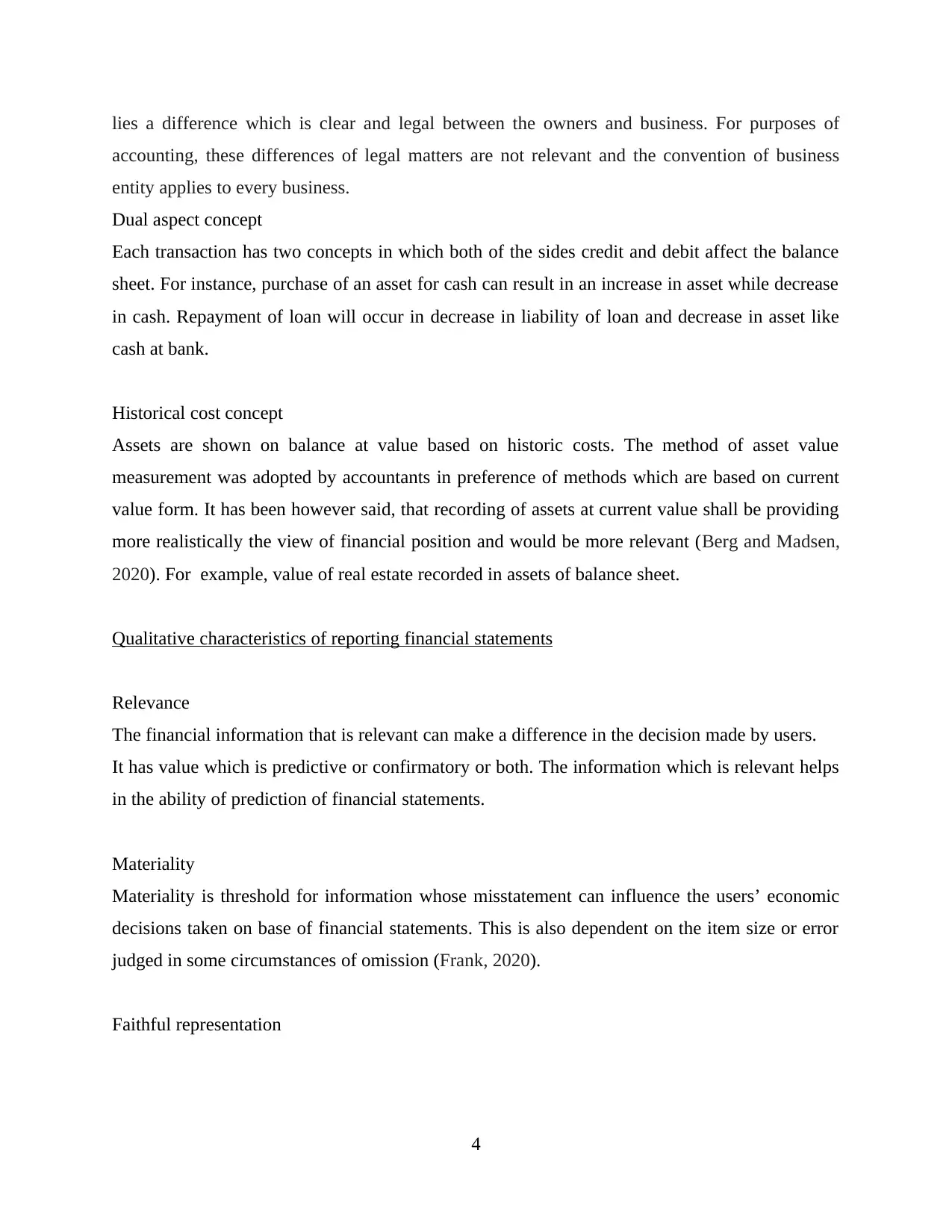
lies a difference which is clear and legal between the owners and business. For purposes of
accounting, these differences of legal matters are not relevant and the convention of business
entity applies to every business.
Dual aspect concept
Each transaction has two concepts in which both of the sides credit and debit affect the balance
sheet. For instance, purchase of an asset for cash can result in an increase in asset while decrease
in cash. Repayment of loan will occur in decrease in liability of loan and decrease in asset like
cash at bank.
Historical cost concept
Assets are shown on balance at value based on historic costs. The method of asset value
measurement was adopted by accountants in preference of methods which are based on current
value form. It has been however said, that recording of assets at current value shall be providing
more realistically the view of financial position and would be more relevant (Berg and Madsen,
2020). For example, value of real estate recorded in assets of balance sheet.
Qualitative characteristics of reporting financial statements
Relevance
The financial information that is relevant can make a difference in the decision made by users.
It has value which is predictive or confirmatory or both. The information which is relevant helps
in the ability of prediction of financial statements.
Materiality
Materiality is threshold for information whose misstatement can influence the users’ economic
decisions taken on base of financial statements. This is also dependent on the item size or error
judged in some circumstances of omission (Frank, 2020).
Faithful representation
4
accounting, these differences of legal matters are not relevant and the convention of business
entity applies to every business.
Dual aspect concept
Each transaction has two concepts in which both of the sides credit and debit affect the balance
sheet. For instance, purchase of an asset for cash can result in an increase in asset while decrease
in cash. Repayment of loan will occur in decrease in liability of loan and decrease in asset like
cash at bank.
Historical cost concept
Assets are shown on balance at value based on historic costs. The method of asset value
measurement was adopted by accountants in preference of methods which are based on current
value form. It has been however said, that recording of assets at current value shall be providing
more realistically the view of financial position and would be more relevant (Berg and Madsen,
2020). For example, value of real estate recorded in assets of balance sheet.
Qualitative characteristics of reporting financial statements
Relevance
The financial information that is relevant can make a difference in the decision made by users.
It has value which is predictive or confirmatory or both. The information which is relevant helps
in the ability of prediction of financial statements.
Materiality
Materiality is threshold for information whose misstatement can influence the users’ economic
decisions taken on base of financial statements. This is also dependent on the item size or error
judged in some circumstances of omission (Frank, 2020).
Faithful representation
4
Paraphrase This Document
Need a fresh take? Get an instant paraphrase of this document with our AI Paraphraser
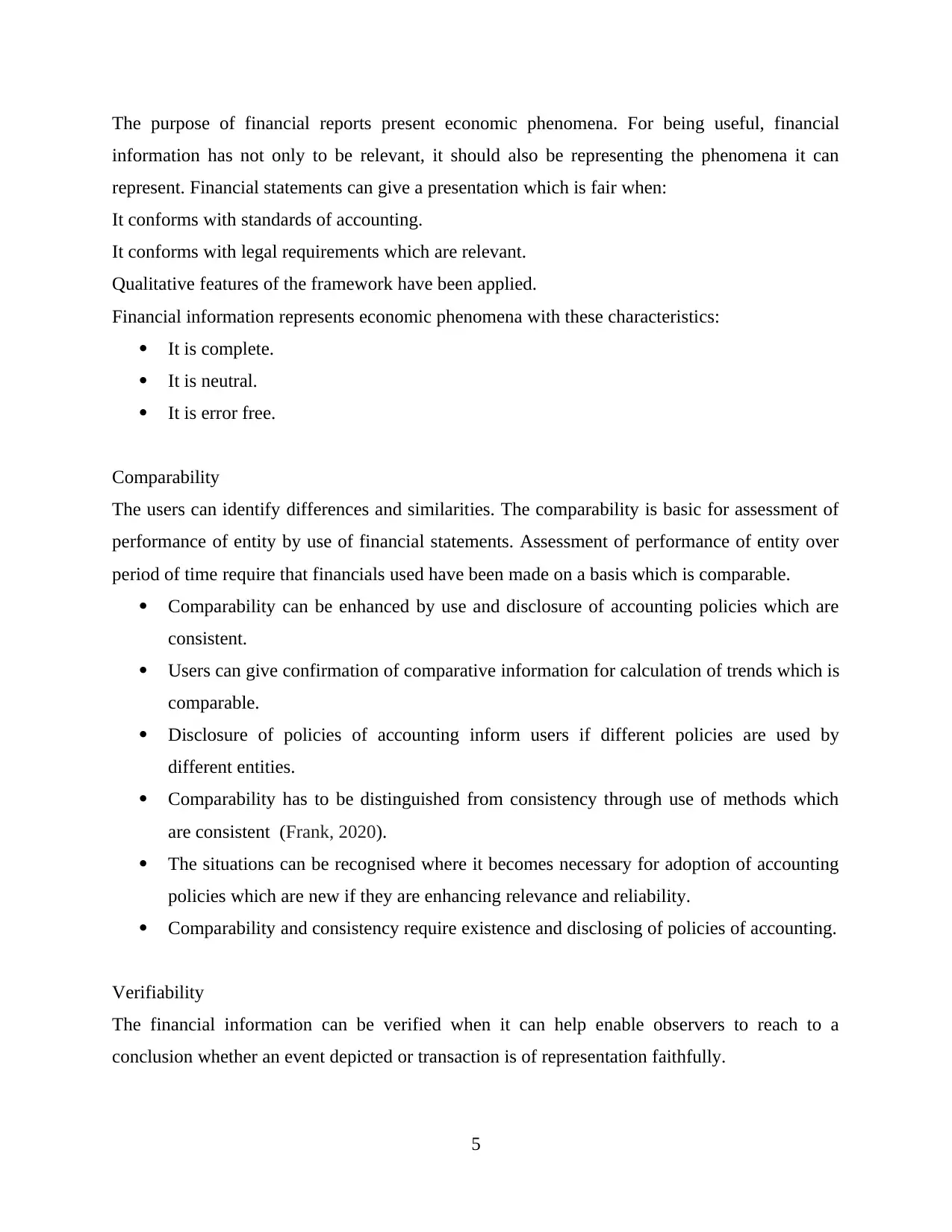
The purpose of financial reports present economic phenomena. For being useful, financial
information has not only to be relevant, it should also be representing the phenomena it can
represent. Financial statements can give a presentation which is fair when:
It conforms with standards of accounting.
It conforms with legal requirements which are relevant.
Qualitative features of the framework have been applied.
Financial information represents economic phenomena with these characteristics:
It is complete.
It is neutral.
It is error free.
Comparability
The users can identify differences and similarities. The comparability is basic for assessment of
performance of entity by use of financial statements. Assessment of performance of entity over
period of time require that financials used have been made on a basis which is comparable.
Comparability can be enhanced by use and disclosure of accounting policies which are
consistent.
Users can give confirmation of comparative information for calculation of trends which is
comparable.
Disclosure of policies of accounting inform users if different policies are used by
different entities.
Comparability has to be distinguished from consistency through use of methods which
are consistent (Frank, 2020).
The situations can be recognised where it becomes necessary for adoption of accounting
policies which are new if they are enhancing relevance and reliability.
Comparability and consistency require existence and disclosing of policies of accounting.
Verifiability
The financial information can be verified when it can help enable observers to reach to a
conclusion whether an event depicted or transaction is of representation faithfully.
5
information has not only to be relevant, it should also be representing the phenomena it can
represent. Financial statements can give a presentation which is fair when:
It conforms with standards of accounting.
It conforms with legal requirements which are relevant.
Qualitative features of the framework have been applied.
Financial information represents economic phenomena with these characteristics:
It is complete.
It is neutral.
It is error free.
Comparability
The users can identify differences and similarities. The comparability is basic for assessment of
performance of entity by use of financial statements. Assessment of performance of entity over
period of time require that financials used have been made on a basis which is comparable.
Comparability can be enhanced by use and disclosure of accounting policies which are
consistent.
Users can give confirmation of comparative information for calculation of trends which is
comparable.
Disclosure of policies of accounting inform users if different policies are used by
different entities.
Comparability has to be distinguished from consistency through use of methods which
are consistent (Frank, 2020).
The situations can be recognised where it becomes necessary for adoption of accounting
policies which are new if they are enhancing relevance and reliability.
Comparability and consistency require existence and disclosing of policies of accounting.
Verifiability
The financial information can be verified when it can help enable observers to reach to a
conclusion whether an event depicted or transaction is of representation faithfully.
5
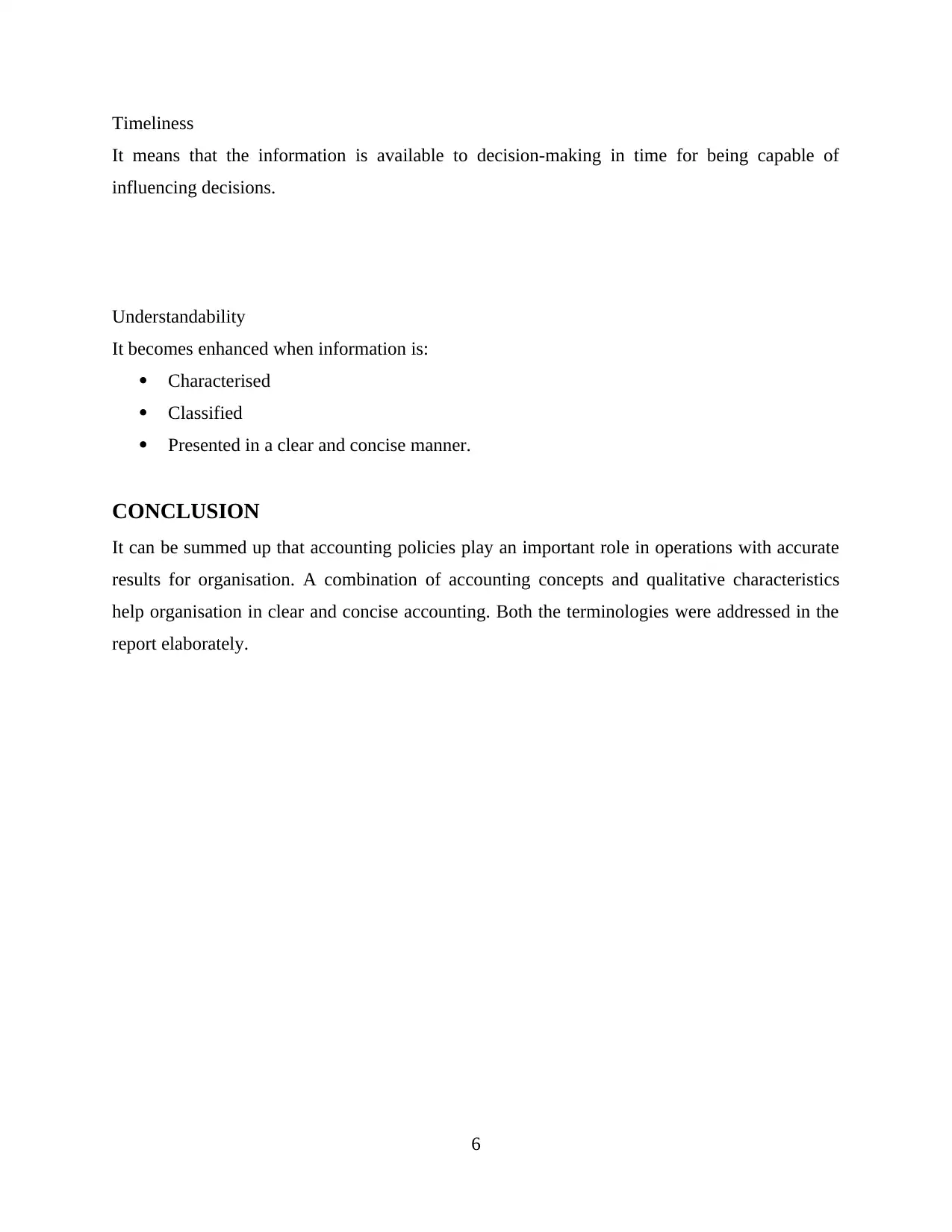
Timeliness
It means that the information is available to decision-making in time for being capable of
influencing decisions.
Understandability
It becomes enhanced when information is:
Characterised
Classified
Presented in a clear and concise manner.
CONCLUSION
It can be summed up that accounting policies play an important role in operations with accurate
results for organisation. A combination of accounting concepts and qualitative characteristics
help organisation in clear and concise accounting. Both the terminologies were addressed in the
report elaborately.
6
It means that the information is available to decision-making in time for being capable of
influencing decisions.
Understandability
It becomes enhanced when information is:
Characterised
Classified
Presented in a clear and concise manner.
CONCLUSION
It can be summed up that accounting policies play an important role in operations with accurate
results for organisation. A combination of accounting concepts and qualitative characteristics
help organisation in clear and concise accounting. Both the terminologies were addressed in the
report elaborately.
6
⊘ This is a preview!⊘
Do you want full access?
Subscribe today to unlock all pages.

Trusted by 1+ million students worldwide
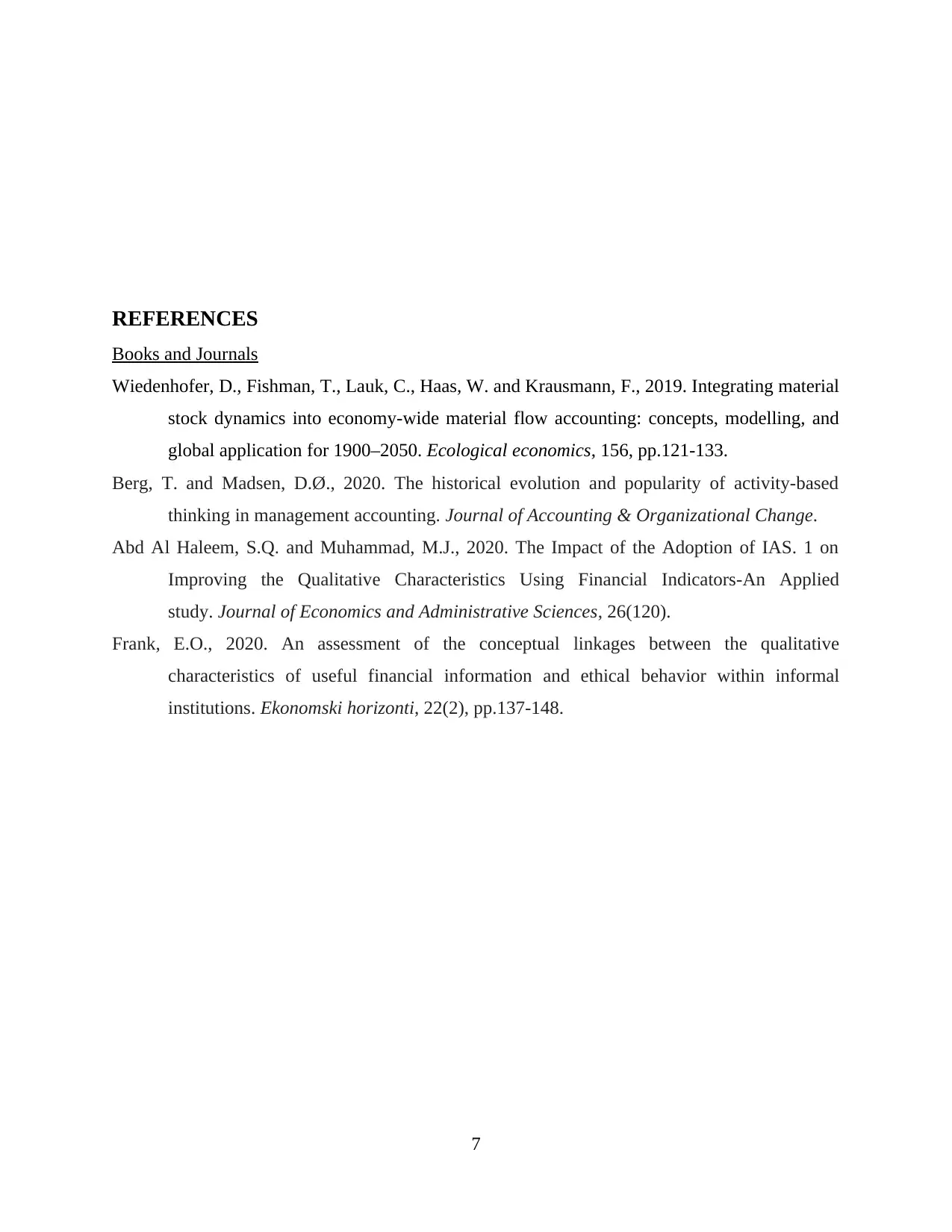
REFERENCES
Books and Journals
Wiedenhofer, D., Fishman, T., Lauk, C., Haas, W. and Krausmann, F., 2019. Integrating material
stock dynamics into economy-wide material flow accounting: concepts, modelling, and
global application for 1900–2050. Ecological economics, 156, pp.121-133.
Berg, T. and Madsen, D.Ø., 2020. The historical evolution and popularity of activity-based
thinking in management accounting. Journal of Accounting & Organizational Change.
Abd Al Haleem, S.Q. and Muhammad, M.J., 2020. The Impact of the Adoption of IAS. 1 on
Improving the Qualitative Characteristics Using Financial Indicators-An Applied
study. Journal of Economics and Administrative Sciences, 26(120).
Frank, E.O., 2020. An assessment of the conceptual linkages between the qualitative
characteristics of useful financial information and ethical behavior within informal
institutions. Ekonomski horizonti, 22(2), pp.137-148.
7
Books and Journals
Wiedenhofer, D., Fishman, T., Lauk, C., Haas, W. and Krausmann, F., 2019. Integrating material
stock dynamics into economy-wide material flow accounting: concepts, modelling, and
global application for 1900–2050. Ecological economics, 156, pp.121-133.
Berg, T. and Madsen, D.Ø., 2020. The historical evolution and popularity of activity-based
thinking in management accounting. Journal of Accounting & Organizational Change.
Abd Al Haleem, S.Q. and Muhammad, M.J., 2020. The Impact of the Adoption of IAS. 1 on
Improving the Qualitative Characteristics Using Financial Indicators-An Applied
study. Journal of Economics and Administrative Sciences, 26(120).
Frank, E.O., 2020. An assessment of the conceptual linkages between the qualitative
characteristics of useful financial information and ethical behavior within informal
institutions. Ekonomski horizonti, 22(2), pp.137-148.
7
1 out of 7
Related Documents
Your All-in-One AI-Powered Toolkit for Academic Success.
+13062052269
info@desklib.com
Available 24*7 on WhatsApp / Email
![[object Object]](/_next/static/media/star-bottom.7253800d.svg)
Unlock your academic potential
Copyright © 2020–2025 A2Z Services. All Rights Reserved. Developed and managed by ZUCOL.





